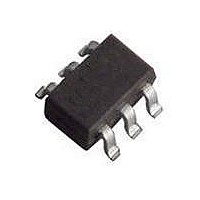BGA2776 T/R NXP Semiconductors, BGA2776 T/R Datasheet - Page 4

BGA2776 T/R
Manufacturer Part Number
BGA2776 T/R
Description
RF Amplifier TAPE-7 MMIC-RFS
Manufacturer
NXP Semiconductors
Type
MMIC Wideband Medium Power Amplifierr
Datasheet
1.BGA2776115.pdf
(10 pages)
Specifications of BGA2776 T/R
Operating Frequency
1 GHz
Noise Figure
4.9 dB
Bandwidth
2800 MHz
Operating Supply Voltage
5 V
Supply Current
24.4 mA
Maximum Power Dissipation
200 mW
Maximum Operating Temperature
+ 150 C
Mounting Style
SMD/SMT
Package / Case
SOT-363
Number Of Channels
1 Channel
Lead Free Status / RoHS Status
Lead free / RoHS Compliant
Other names
BGA2776,115
NXP Semiconductors
APPLICATION INFORMATION
Figure 2 shows a typical application circuit for the
BGA2776 MMIC. The device is internally matched to 50 ,
and therefore does not need any external matching. The
value of the input and output DC blocking capacitors C2
and C3 should be not more than 100 pF for applications
above 100 MHz. However, when the device is operated
below 100 MHz, the capacitor value should be increased.
The nominal value of the RF choke L1 is 100 nH. At
frequencies below 100 MHz this value should be
increased to 220 nH. At frequencies above 1 GHz a much
lower value must be used (e.g. 10 nH) to improve return
losses. For optimal results, a good quality chip inductor
such as the TDK MLG 1608 (0603), or a wire-wound SMD
type should be chosen.
Both the RF choke L1 and the 22 nF supply decoupling
capacitor C1 should be located as closely as possible to
the MMIC.
Separate paths must be used for the ground planes of the
ground pins GND1 and GND2, and these paths must be as
short as possible. When using vias, use multiple vias per
pin in order to limit ground path inductance.
Figure 3 shows two cascaded MMICs. This configuration
doubles overall gain while preserving broadband
characteristics. Supply decoupling and grounding
conditions for each MMIC are the same as those for the
circuit of Fig.2.
The excellent wideband characteristics of the MMIC make
it and ideal building block in IF amplifier applications such
as LBNs (see Fig.4).
As a buffer amplifier between an LNA and a mixer in a
receiver circuit, the MMIC offers an easy matching, low
noise solution (see Fig.5).
handbook, halfpage
MMIC wideband amplifier
RF input
V s
Fig.2 Typical application circuit.
C1
C2
RF in
GND1
V s
GND2
RF out
L1
C3
RF output
MGU436
Rev. 04 – 29 August 2007
In Fig.6 the MMIC is used as a driver to the power amplifier
as part of a transmitter circuit. Good linear performance
and matched input and output offer quick design solutions
in such applications.
handbook, halfpage
handbook, halfpage
handbook, halfpage
handbook, halfpage
antenna
from modulation
input
from RF
or IF circuit
circuit
Fig.6 Power amplifier driver application.
DC-block
100 pF
Fig.5 RF amplifier application.
oscillator
Fig.3 Simple cascade circuit.
Fig.4 IF amplifier application.
LNA
oscillator
mixer
wideband
mixer
amplifier
oscillator
DC-block
100 pF
wideband
amplifier
mixer
wideband
amplifier
Product specification
DC-block
BGA2776
100 pF
to IF circuit
or demodulator
to IF circuit
or demodulator
to power
amplifier
MGU438
MGU440
4 of 10
MGU437
MGU439
output














